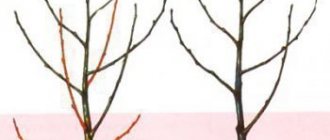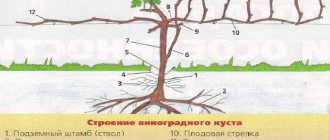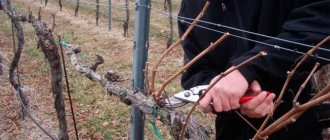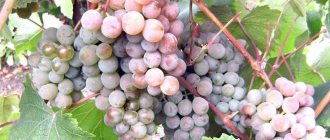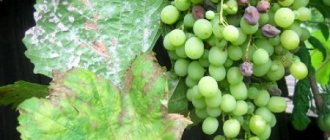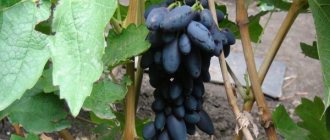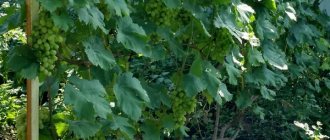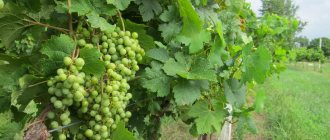Why is spring pruning necessary?
Grapes are a sun-loving plant; they always reach for the sun. It constantly appears new shoots, shoots grow continuously, randomly and unevenly. Why pruning is needed:
- Formation of quality buds. If the shoots grow chaotically and unevenly, the buds are weak and sparse. They produce few inflorescences, many of which are empty flowers.
- Improving the taste of berries. Good buds produce powerful inflorescences, which produce large grapes with a rich taste.
- The vine is formed and excess shoots are removed . The plant tries to direct nutrients to young shoots. When there is an excess of intensively growing branches on the bush, the plant lacks strength to form fruits - all its strength goes into the growth of shoots.
If you skip spring pruning of grapes:
- bushes become overgrown;
- the grapes will become smaller every year;
- the bushes will eventually go wild and lose their varietal characteristics.
Pruning is a mandatory measure to renew the bush and ensure a high yield of berries.
Inexperienced gardeners often regret cutting off excess - they think that by cutting off branches, they are deprived of the harvest. In addition, pruned bushes look rather pathetic at first. The essence of pruning is to provide access to the sun's rays to the top and bottom of the vine.
Why is forming needed?
Grapes grow very quickly, and literally in one season they can entwine everything around.
Shaping is not only a way to reduce the number of vines, but also a measure to increase productivity. Its peculiarity is that the nutrients inside it are distributed unevenly - most of it goes into young shoots, and the old, fruit-bearing shoots weaken and become depleted. Important to know: Spring feeding of grapes
Pruning of grapes in the spring is carried out for the following purposes:
- Increased growth. If you renew the branches in time, they will be better saturated with juices and the nutritional components they contain.
- Thinning the bush. Removing excess branches improves natural ventilation and the plant receives more sunlight.
- Providing access. An overgrown bush complicates harvesting and care.
- Rejuvenation. The life of the vine is significantly extended if old dead branches are removed in a timely manner.
- Frost protection. When the side branches are shortened, the main stems become thicker and tolerate frost better.
Related article:
How to care for grapes in the second and subsequent years
Without this, freely growing grapes will tend to rise, and in parallel, the lower branches will begin to weaken. Gradually the berries are crushed, the bush goes wild and will not produce a harvest at all.
When are grapes pruned?
The timing of pruning grapes depends on a number of factors:
- varieties;
- age of the bush;
- cultivation option;
- climate.
Grapes are pruned in spring:
- early and mid-season;
- with low frost resistance;
- young, with unformed bushes;
- sheltered for the winter.
Spring pruning begins under the following conditions:
- Active sap flow has not begun. If pruning is carried out later, the open sections will begin to exude molasses, and this process cannot be stopped. The bush, losing its life-giving juice, weakens. As a result, the vine grows worse.
If you carry out spring pruning after the start of sap flow, you can not only lose the harvest, but also completely lose the grape bushes.
- The air temperature is set at 5-6˚С.
- Pruning should be done before the buds enlarge. If the buds begin to grow, you are too late!
Tools for cutting
For trimming you will need:
- Secateurs - if a young vineyard is being pruned.
- Powerful garden pruner used for cutting branches of fruit trees. Such a tool is necessary for the rejuvenating removal of thick perennial branches.
- Hacksaw. To remove any thickened branches.
Tool before use:
- Sharpening.
- Wipe with alcohol.
In the video, an experienced gardener shows how to properly sharpen a grape pruning tool:
Preparing tools
It is very important that the tool used to prune grapes in the spring is of high quality and as sharp as possible. The better the cut on the shoot, the faster it will heal. Cuts with uneven or frayed, crumpled edges take a long time and painfully, and such open wounds can become an entry point for various infections.
For pruning you will need the following tools:
- garden file with fine teeth;
- garden pruner;
- garden knife.
The instrument must be clean, otherwise there is a high risk of infection. Before trimming, it is tedious to check the quality of the cuts; if the cutting edges are dull, then they need to be sharpened. All instruments must be disinfected with any alcohol-containing liquid or copper sulfate solution.
Basic rules for pruning
It is important to consider the age of the bushes. Rules for spring pruning of grapes:
- The cut is made at an angle of 90 degrees - so that the open cut heals faster. At a right angle, an open wound will heal faster.
- Eliminate branches:
- sick;
- frozen over the winter;
- received other damage.
At this stage, the cutting pattern is not taken into account.
- Excessively elongated shoots are shortened - so that they develop and form correctly, 7-12 buds are left on them.
- Shoots that bear fruit in the past season are cut off carefully, so as not to break them at the base. The shoots are cut off at a distance of 1.5 cm from the perennial branch.
- To make replacement possible, shoots must be kept close to the main trunk.
- Leave shoots with a diameter of 5-7 mm. Branches outside this range are pruned.
Thick shoots with a diameter of more than 10 mm are called fattening shoots - they interfere with fruiting, so they need to be removed.
When the pruning is finished, the bush looks bald at first, but after a little time it will become lush green. Young shoots, having quickly formed, will put out inflorescences - the source of the future harvest.
Pruning not only allows you to form young bushes, but also restore neglected or frozen ones. Grapes are known for their vitality - they are ready to be reborn again and again, the main thing is to take the chance correctly.
A viticulture specialist explains in a video how to properly carry out spring pruning:
Types of pruning
During the first 3-4 years of life, grape bushes are pruned in order to form them correctly - branches are created that will bear the entire load. Bearing branches are formed in stages. You can form a bush using the following methods:
- standard;
- without standard.
In both cases you must comply with:
- recommended pruning pattern;
- timing of pruning;
- care requirements.
Standard and non-standard formation differ from each other in the following features:
- Standard pruning . The main stem is formed - the supporting branches of the grape bush extend from it. The stem has a height of 200-800 cm.
- Standardless pruning . The basal head emits several bearing branches - 2 or 4.
Standard trimming
This method of pruning is used if grapes are grown without shelter for the winter, for frost-resistant varieties grown in large volumes. Standard pruning is also used by winegrowers in warm climate zones.
Grape bushes that are well cared for grow for more than a hundred years.
The formation of the trunk is carried out in the first year of planting grapes. Performing standard pruning by year of life:
- First year . Top trimming. Leaving 2 buds after the root, rids the seedling of excess growth.
- Second. The stamp is not affected. Remove shoots that have grown over the past season. Having found the most powerful shoot, cut off its top so that 7 to 12 buds remain. One small shoot is left as a replacement - it is shortened to 2-3 eyes.
- Third. This year the height and shape of the trunk is formed. The shoots left earlier become load-bearing “sleeves” - they are reduced by 2 buds and then tied to supporting supports. Then the shoots left for the sake of reserve are shortened - 2 buds are removed from one (they are left as a replacement knot), 5-6 eyes are removed from the second.
- Fourth. The time has come to trim the upper “sleeves” and remove all unnecessary shoots - the bush is formed as the winegrower wishes.
- Fifth . Only the main branches forming the fruiting structure of the bush are left. All excess is cut off.
- Sixth. When forming a bush, 2 buds are cut off from the replacement knot, and the fruit shoot is shortened, leaving 7-8 buds.
Thanks to standard pruning, it is possible to obtain abundant harvests while economically using space.
Standardless pruning
This is a faster forming method. Three years are enough for properly growing grapes to produce an enviable harvest. The order of standardless pruning by year:
- First year. Remove shoots with damage and deformations. It is also necessary to remove 90% of the young growth. The remaining sprouts - 2 pieces, are cut off, leaving 2-3 cm after the 2nd bud.
- Second. This year, 60% of the growth is removed. Only 2 shoots should be left on the sprouts - the most powerful ones are chosen, since they will have to bear the load of the ripening bunches. Shortening should leave 2-3 buds on the shoots - many shoots will sprout here before autumn.
- Third . Stage of formation of fruit links. The lower vine is pruned by 2-3 buds, the upper vine (fruit shoot) by 7-10 buds. This is how load-bearing “sleeves” are formed - two vines are left for each of them, and all other shoots are removed.
In order for the grapes to delight you with harvests, it is important to follow the rule - when pruning, fruit-bearing shoots and 2 or 3 branches are left, which will later help renew the crown.
Bush formation
Let's look at the main types of grape formations on the basis of which autumn pruning is carried out.
Fan
The fan formation of grapes allows you to get powerful bushes, the vines of which can carry up to 50-60 kg of harvest. The best trellis for fan forming is a V-shaped two-plane one. According to this formation, the bush leads into two branches (perennial). Two fruiting links extend from each sleeve, consisting of one fruiting arrow and one replacement knot. Thus, a total of four fruit-bearing young shoots should remain per bush.
Fan molding of grapes
Stambovaya
The standard formation is interesting when a tall standard is formed, 1.2-1.5 m long. The crown of a grape bush can be located in the form of a tent, which is pruned in the summer - such plants look very impressive on plantations and in landscape design. In addition, you can get up to 25-30 kg of harvest from them.
One or two sleeves can extend from the formed trunk in different directions of the trellis (perennial wood). The length of the sleeves corresponds to the growth strength of the bush and the capabilities of the trellis: from 80 cm to 1.4-1.5 m. The vines are cut on the sleeves so that 4-6 fruit links are formed.
Standard pruning of grapes
The Guyot formation is the easiest for beginning winegrowers to master. She is standardless. From the base of the bush, one or two fruit links are immediately formed in different directions of the trellis or only on one side (one-armed Guyot).
Pruning grapes using the Guyot method
When pruning grapes annually, you need to follow the chosen pattern for forming the bush in the first year of growth. In the second and subsequent years it is only necessary to maintain it.
Standardless grape formation is the most common. To what length the sleeves should be cut, you need to look at the characteristics of each variety. In the first autumn after planting, only the two most powerful shoots are left, which in the spring are pruned to two eyes each. If only one shoot was able to develop, then we leave 4 eyes on it. Of these, 4 shoots will subsequently develop - this is how a four-armed (fan) formation will be formed.
The next spring (second) these shoots are pruned to two buds each, and all other growth is removed. In the third spring, a fruit arrow with a replacement knot will form, as shown in the diagram below. Then we can only maintain this method of shaping and pruning grapes.
The standard forming of grapes is ideal for frost-resistant, uncovered varieties. In the first year after planting the seedling, it is necessary to leave only one of the strongest shoots and trim it to two or three eyes. In the future, it will serve as a standard, and the second shoot is needed as a backup. All unnecessary shoots and stepsons are removed as they grow, the main shoot (trunk) is tied to a peg.
In order for the shoot to ripen better, the growing point is pinched off by the end of August. In the third year, the reserve sleeve is cut to 2-3 buds with a replacement knot, and the trunk is cut to the required length with two shoots on it, which are tied to a wire. Excess shoots must be trimmed according to the characteristics of the variety. See the diagram of standard grape pruning in the photo below.
The fourth, fifth and sixth years - all excess shoots are broken off, the distance between the main ones should be approximately 20 cm. Fruit vines are pruned to 6-10 buds, and replacement knots to 2. In the future, you need to adhere to this method of pruning grapes. When forming a bush in one row, we leave two fruit arms, when forming a bush in two rows - 4, and so on.
On the spare sleeve, the lower knot is trimmed to 2-3 eyes, and on the upper one we leave from 8 to 15 buds. The procedure is repeated every year.
For cordon formation, a wire trellis is required, to which the grape sleeves will be tied. The bush can be formed on one or two shoulders (cordons), horizontally or with a slope. On these shoulders there are evenly fruiting links, which consist of a fruit vine and a replacement knot - you can see this in the diagram below.
Pruning of grapes using the cordon system is formed no earlier than the third year - this is especially true for new winegrowers. Only experienced gardeners in the southern regions of the country will be able to form faster. But it’s still better not to rush (after all, patience is rewarded), but to grow strong shoots from which the shoulders will form.
In the second or third year, our task is to grow sleeves; the distance between them varies from 20-30 cm to 1 meter - this depends on the varietal characteristics of the grapes. Extra stepsons break off. Most often, the distance between the sleeves is within 50 cm; it suits most varieties. We leave no more than 4-5 sleeves on one shoulder; for more convenient care, we leave only those located on top, and remove the lower ones.
Cordon horizontal formation of grapes
If you want to use a formation without replacement knots, then at this stage it is already ready and all you have to do is maintain it every year, removing the fruiting vine to 3-4 buds.
In the fourth year, the shoots are cut to two buds, with a replacement knot and a fruiting link, on which 3 to 5 buds remain. All the lower eyes break off, the shoulder of the cordon is cut to 50 cm above the lower eye.
Cordon formation of grapes on two shoulders
By the fifth year, the shoulder already reaches the neighboring grape bush, we cut off or pinch out the outer buds, and replace the old sleeves with new ones. And after 10-12 years, the cordon shoulders themselves will have to be changed, replacing them with new shoots.
Thanks to the accelerated formation method, the grape harvest can be obtained a year earlier. So, on a young annual seedling, the tops above 4-5 leaves are pinched to accelerate the development of the stepsons. This technique can be used for various types of formation: fan, cordon, Guyot. In subsequent years, pruning is carried out as expected, taking into account the chosen type of bush formation.
Pruning fruiting grapes
Thanks to green operations on fruit-bearing grapes, it is possible to regulate the growth and yield of bushes. Sometimes you have to remove excess fruit-bearing shoots if the grape bush is overloaded.
Wreckage
The formation of a bush of debris is accelerated, errors made during pruning are eliminated. Improves ventilation and warming. Debris rules:
- Removing unnecessary shoots growing on the head and sleeves of the bush. The shoots are left for replacement and renewal. In varieties with uneven germination of shoots from dormant eyes, cutting is carried out twice.
- First of all, green shoots growing in the crowns are broken off.
- If the bushes are underloaded, debris is not needed.
- The cutting is done by breaking out the shoots down to the woody trunk.
Late cutting is done with pruning shears, but it harms the bush and weakens the plant.
Pinching stepsons
Young grassy shoots growing on the fruit shoot are pinched. Purposes of pinching stepchildren:
- accelerating the restoration of the leaf crown or skeleton;
- stopping the growth of shoots - to prevent shedding.
On underloaded bushes, pinch out vigorous shoots - several pieces, above the 3rd or 5th bud. The stepsons obtained after pinching can be used next year to form a fruit link.
An expert will tell you how to properly pincher grapes and how pinching affects yield in the following video:
Coinage
It is done to speed up the ripening of berries - while slowing down the growth of green shoots. Remove the retracted crowns, 4-7 buds at a time. Conditions for minting:
- irrigation;
- strong shoot growth;
- poor ripening.
If grapes are grown without watering, minting is not done. Also, it is not needed for low-growing varieties.
Pruning old grapes
Pruning old bushes is necessary for optimal thinning and high-quality formation of a trunk that is much stronger and therefore resistant to various diseases or frosts. As a result, after just two years, it is possible to produce a completely stable fruit-bearing grape variety from an old, disordered bush with the help of proper pruning. It will be sufficient to use the following step-by-step instructions:
1. Remove dead shoots/vines. Here, standard pruning is performed after wintering. If it is not entirely possible to understand which stems of the plant have died and which are still alive, then it is recommended to cut off a small part of the suspicious vine and take a closer look at its inside. If it has a light green color, then the vine is still alive; when the cut is not green at all, then the vine is considered dead. But there is no need to rush to cut it off completely - it is better to double-check it several more times, making and examining the cuts from top to bottom along the selected shoot. 2. Selection of the method of forming a bush. To rejuvenate outdated bushes, “Fan formation” or “Horizontal cordon” is recommended. When you plan to grow fruits on an arch or gazebo, you can find out about the formation of an arched type below. 3. Eradication of all unnecessary vines according to the formation. If, after the initial pruning of dead branches, there are not enough vines to complete the task, you should not be upset - it will be possible to begin forming the missing branches next year, using the most suitable growth for this purpose.
Pruning an adult grape bush video
Spring pruning of damaged bushes
If the grapes are frozen over the winter, there is a good chance of restoring the plant. At least partially. Let's consider a method of restorative pruning after various damages.
The bushes are frozen
First, check the condition of the kidneys by making incisions on them:
- green color indicates kidney health;
- black and dark brown - about damage.
The cuts are made moving from the base to the top of the branch. By counting the dead eyes, the amount of damage is calculated. Depending on the damage, take the following actions:
- If the death rate was less than 80%, leave more buds during formation than provided for in the scheme. An additional harvest is obtained thanks to shoots on fruit-bearing branches left during autumn pruning.
- If more than 80% have died, sanitary pruning is needed in two stages. Before the buds open, remove frozen branches and damaged supporting sleeves. When greenery appears, sanitary pruning is completed by removing excess growth.
- If the damage is 100%, the stepsons are checked - being more frost-resistant, they more often survive the winter. If the buds on the stepsons have also died, you can form fruit-bearing links from young shoots or fattening shoots growing from buds on perennial branches.
Frostbite of the root system
In frosty winters with little snow, part of the grape root system is damaged or dies. Necessary actions:
- They dig up the ground at the will of the bush.
- Root cuts are made. The sections of undamaged roots are white, while those of frostbitten roots are dark brown. If the frostbite diameter of the roots is up to 2.5 mm, the vine will recover next year. The main task of the gardener is to reduce the load on the root system by cutting off the fruiting branches short.
Spring hail
If there was hail in the spring and the bushes lost a lot of foliage, young shoots are pruned to 1-2 buds. Then shoots will appear, which are thinned out - this is done to activate the reserve buds, which will bear fruit the next year.
Cold snap
Frosts often occur in the spring just as the buds are opening. They can not only destroy new buds and shoots, but also a one-year-old vine. Further actions depend on the degree of damage caused:
- The vine is damaged. It is recommended to cut last year's branches short to stimulate the growth of other shoots - then the dormant buds will awaken.
- If frosts have damaged the green part and flowers, to awaken dormant buds you need to shorten the annual shoots - this will help partially restore the harvest.
- If the tops of the branches are damaged, as well as a small part of the leaves and inflorescences, you can do without special pruning.
Timing of pruning
Spring is considered the optimal time for pruning young grape bushes. New shoots formed during this period have time to strengthen and ripen before the end of the growing season, replenishing the supply of perennial wood of the bush and guaranteeing a successful wintering for the grapes.
Mature bushes that have entered the fruiting period can be pruned both in spring and autumn. This usually depends on the specific variety (covered or uncovered) and the growing region. In any case, pruning should be done while the plants are dormant, before the beginning of the growing season. For uncovered grapes with high frost resistance of bushes, it is advisable to start pruning in late autumn (2-3 weeks after leaf fall) and continue until early spring, when sap flow begins. The only limitation for pruning is a drop in air temperature below minus five degrees.
For covering grape varieties, pruning is carried out in two stages:
- Preliminary (autumn) - before the onset of cold weather and covering the bushes for the winter. Pruning is carried out on the mature vine to form fruit links for next year's harvest.
- Main (spring) - after the bushes open in early spring, before the buds open. During the pruning process, the number of intact fruit buds (eyes) is determined.
During spring pruning, all damaged parts of the bush, weak and fattening shoots, and old sleeves without fruit-bearing vines are removed.
Video: when to prune grapes, choosing a vine for pruning
Arch trimming
For arches, frost-resistant grape varieties are chosen, since the branches are not covered for the winter. The trimming scheme is selected taking into account:
- features of supports;
- characteristics of the variety.
Pruning arched grapes is no different from pruning bushes tied on a trellis. Arched grapes are distinguished by abundant fruiting, incomparable with harvests obtained on trellises.
If you have a warm climate, you can plant the Original and Svetly varieties, since they are not frost-resistant, but they grow very quickly - in 1-2 months, even with heavy spring pruning they cover the entire arch with greenery. It is recommended to trim the fruit shoots to 10-12 buds.
If you need an uncovered frost-resistant variety, it is better to take the Timur, Arochny, Talisman varieties - these are vigorous varieties that are resistant to disease. The formation of bushes is carried out together with the construction of the arch:
- the first wire of the arch is placed at a distance of 50 cm from the ground;
- further - at intervals of 30-40 cm.
When shoots appear, only one is left - all the others are cut out. A standard is formed from the left shoot. A shoot that has grown to the first wire produces two shoots. The person’s task is to leave the stepsons and form the sleeves – left and right. At a distance of 2 m, two more sleeves are laid. Trimming rules:
- Fruit vines are laid along the sleeve and cut to a certain number of eyes - it depends on the variety. From each left bud a shoot grows. The bush is formed using fruit shoots.
- The vine that has finished bearing fruit is removed along with the growth. The top vine, grown on a replacement knot, is placed in the vacant space. The lower replacement shoot is shortened by two buds.
Trimming technologies
So, let us examine in detail the sequence of actions when pruning grapes:
- We clear the bush from the ground below. It is necessary to remove all thin, green shoots coming from the underground part of the bush.
- Remove last year's part of the bush.
- Select a young shoot of the current year that will form the fruit shoot and cut it to the required number of eyes.
- Select a replacement shoot for the fruit shoot and cut it into two eyes.
Watch a video for beginners on pruning grapes in the fall for free here.
Trimming the gazebo
Pruning grapes in the fall on an arbor may seem too difficult for beginners. However, don't despair. Let's look at what needs to be done step by step:
- Assess the amount of work - is the roof of the gazebo formed by grape vines or covered with building material? In the first case, there will be more work and the vines will be stronger and longer. In the second case, you need to trim as much as possible, leaving three or four main fruit shoots 6-10 eyes long.
- On gazebos, as a rule, a lot of extra, thickening shoots are formed - they all need to be removed.
- Place the remaining shoots evenly over the area of the gazebo, then in the spring the young greenery will create an even canopy that will reliably protect you from the scorching sun.
Pruning grapes on an arbor
Pruning old winter-hardy grapes is particularly difficult. Initially, select young vines that should be left for fruiting next year. Leave a replacement shoot for each young vine. Then remove all small and old shoots around them. After this, clear the base of the bush, freeing it from overgrowth.
It is recommended to rejuvenate old table grape bushes that are sheltered for the winter every 4-5 years. To do this, in advance, in the spring, they leave a shoot from among the coppice, which will serve as a sleeve in the future. In autumn, the old sleeve, which carries all the shoots, is removed, and a fruiting link is formed on the new one. Watch a video for beginners on pruning neglected grapes in the fall.
Popular methods of shaping grapes
The formation process begins 1-2 years after planting the seedlings, and it lasts from 3 to 6 years - depending on the chosen modeling method. The process is completed when the bush and vine pattern appears and full fruiting is achieved.
Guyot's scheme
Used in cold regions for covering grapes. Considered a classic of the genre. This simple method allows you to cover the entire bush with sun. Suitable for beginner gardeners. Guyot's scheme:
- In the first year, a strong shoot is grown. It is pruned in the fall, leaving 2-3 eyes.
- In the second year, two shoots grow, they are pruned in the fall - 2-3 buds are left on one, the second is left long - the clusters will ripen on it.
- After a year, a twig and a vine will grow from the twig again.
The fruiting vine is formed using imagination and the load of the bush is adjusted. By changing the length of the arrows, the size of the bunches changes.
Fan formation
The most popular option when modeling bushes. It differs from the Guyot scheme in the large number of sleeves - there are 3-5 of them, not 1-2. Different fan formations can be performed:
- big or small;
- with short or long sleeves;
- standard or non-standard;
- one- and two-sided;
- single and double tier.
In cold conditions, the standardless version is more often used - a fan and a one-sided half-fan. Its advantages:
- convenient to care for bushes;
- convenient to cover;
- easy to carry out rejuvenation;
- The berries will be obtained with excellent taste properties.
The procedure for forming a bush with a fan:
- The first two years of operation are no different from the previous method.
- In the third year, sleeves are made - 2 vines are formed on each of them. By the third year the bush bears fruit, producing at least 4 shoots - they grow up to 1 m in length and 6-10 mm in thickness.
- The first tying is done in the spring. The sleeves are tied to the bottom wire (30-60 cm from the ground), forming a “fan”.
- In the spring, the shoots are pruned, making them shorter inside the fan than outside.
- While growth is underway, annual shoots are constantly removed from the sleeves, leaving 2-3 at the top - they are needed to form new fruiting links and lengthen the sleeves. The garter to the trellis is performed vertically.
- For 4-5 years, fruit links are created on the sleeves. To form the arrow that forms the fruit, cut the upper vine by 4-6 buds, and cut the lower vine by 2-3 buds.
Fan pruning of grapes in spring for beginners in pictures step by step
The fan formation of a bush is one of the most popular and its general essence is that a bush is formed from a plant with several perennial vines and young ones on them. There are two types of fan-shaped bushes: multi-armed and one-sided types. Each gardener chooses the type of pruning independently, based on the grape variety, the location of the bush on the site, and even just personal preferences. In general, the number of branches (perennial grape vines) varies from three to eight.
The formation of a bush in stages is as follows:
1. In the first year, it is worth growing two strong shoots on a young bush. To do this, try to choose two shoots growing from oppositely located eyes. The remaining shoots will need to be pruned when each shoot reaches a length of approximately ten centimeters. During the summer, the shoots are tied as vertically as possible. By autumn, the selected shoots will grow well, become woody and strong. In the fall, these shoots need to be trimmed again, leaving four eyes on each.
First year
2. In the second year of the plant’s life, it is necessary to grow four strong shoots, two on each of last year’s shoots. Pruning is done, again, when the sprouts have reached ten centimeters in length. As in the first year, it is preferable to choose oppositely located eyes. During the growth process, these branches are already tied at an angle of 45°.
Second year
3. In the third year, you will have to decide whether to leave the bush with four branches, or to increase their number further. In general, further increase in the number of branches will take place in parallel with the cultivation of fruit units and harvesting, respectively. It is also possible to grow a multi-fan bush with knot replacement, which is also done simultaneously with the cultivation of fruit vines. Basically, in the third year, fruit links are formed on the sleeves grown over previous years, leaving from two to four new vines on each of the sleeves.
Third year
Care after pruning
The larger the cutting diameter, the greater the danger. The plant weakens after repeated pruning, and even its death is possible. To keep the damage to a minimum, you need to:
- use sharp pruners;
- remove branches with a diameter of 2-8 cm using a bow saw, and cut old branches with a hacksaw;
- try to ensure that the cuts are located on one side - then food will flow to all branches;
- the stumps of thick branches should be less than 1 cm. Otherwise, they will crack and damage the integrity of the wood.
To mitigate the damage caused, it is recommended:
- Clean the wounds with a garden knife. This helps prevent water from accumulating on the cuts - fungus can penetrate through it, causing rot.
- Regularly loosen the soil within a radius of 40-60 cm from the bushes.
- Weed, water and feed plants in a timely manner.
- Treat plants against diseases and pests in a timely manner.
- When the shoots reach a length of 25 cm, bend them down and tie them to supports.
Common Mistakes
When pruning grapes, inexperienced gardeners often make the following mistakes:
- When sparing the plant, they do not cut off the growth, but only shorten the tops and remove dry shoots. After a few years, the vine will intertwine so that it obscures the sun - the fruit-bearing branches will not receive additional energy, and the fruits will be small and tasteless.
- Shoots are cut to the wrong length. In spring, you need to take into account that the length of the cut part is determined by the thickness of the shoot. The thicker the vine, the longer its length after pruning.
- Thinking that thick vines yield more yields, gardeners harvest young vines instead.
Thanks to proper and timely pruning, grape bushes will produce abundant harvests. And the berries that ripen in clusters will be juicy, large, and rich in flavor.
0
0
Copy link
Features of grape pruning
Once you understand a few basic principles, the annual routine of pruning grapes will become simple and straightforward. Here's a secret: bunches of grapes grow on one-year-old wood, i.e. on the one you cut last year. First, the bud produces a vine, which turns from green after a year to brown. It is on it that the grapes will grow next year. Old wood produces only leaves and shoots.
By cutting off as much old wood as possible, you will stimulate the growth of new wood, on which the crop will grow. Left to its own devices, the vine will grow so that air circulation is poor, fungal diseases will develop, and the berries will be crushed. As a result, your grape bush will go wild, which will lead to the loss of a quality harvest and complicate subsequent care.

